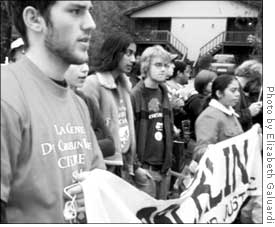
| << Front page | News | December 2, 2005 |
Obies Join Protests at Military Training School
 |
||
| SOA Protest: Obies demonstrate at the annual SOA protest in Fort Benning, Ga. | ||
On Saturday, Nov. 20, between 50 and 60 Obies piled off buses, stretching and blinking in the warm Georgia sun from lack of sleep. We had come 16 hours from Oberlin to Columbus, Ga. for the annual rally and vigil to close the School of the Americas.
The School of the Americas, or Western Hemisphere Institute for National Security Cooperation as it is now called, is a military installation on the grounds of Fort Benning, long criticized for its training of Latin American dictators, torturers and death squads.
The two-day event is organized each year by SOA Watch, a group founded by Father Roy Bourgeois, a survivor of torture at the hands of SOA graduates. The movement grew throughout the 1980s and ’90s and yearly attracts more and more activists to the gates of Fort Benning.
On Saturday, we attended the day’s main event, a rally along the length of Fort Benning Road. This suburban street leads right up to the fort’s entrance, which is marked by three tiers of chain link fence topped with barbed wire. The last house on the street had a laundry line affixed to the fence. The fence bore red, white and blue shields warning the public, “U.S. Property, No Trespassing.” At the gate, people kneeled in prayer.
The street was lined with people tabling for various causes, selling T-shirts, gathering signatures and playing music. At the street’s end there was a stage erected with sound equipment and speakers ranging from George Martin, of United for Peace and Justice, to Salvadoran torture survivors. The survivors delivered the good news that recently some of the school’s most notorious graduates have been convicted in U.S. courts under a law dating back to the 18th century.
The rally wound down and we reboarded our buses to go to the Columbus Convention and Trade Center where we could attend various panel discussions, presentations, movies and meetings. I sat in on a legislative training, where SOA Watch organizers outlined a month-by-month plan to have legislation to shut down the school finally pass in the House of Representatives.
“It’s really exciting to be looking at a [congressional] vote this summer,” said Ellen Barfield, a member of SOA Watch’s Legislative Committee, at one meeting. She added that the bill now has 126 sponsors, and SOA Watch believes that with 150, the bill, titled HR 1217, will pass.
Exuberance spilled out of the convention center as a dense, mainly youthful crowd filled the outdoor pavilion with drumming, dancing and chanting in a cathartic celebration of release preceding Sunday’s somber mourning.
After this revelry, we reboarded the buses to spend the night at a Christian retreat where we slept on the floors of a chapel and library. Early the next morning we went back to the base, where the weather was cooler and gray, and police barricades had been erected, narrowing the corridor of Fort Benning Road. Protesters jammed in to hear the speakers.
“It seems to me that people are finally paying attention to my message,” said Carlos, a Salvadoran torture victim, on stage. “We know now the U.S. army is torturing prisoners, and we’re saying, ‘No more!’”
The word came from the stage: a record-breaking 20,000 people were present. Carrying simple wooden crosses, many with names of victims of SOA graduates, marchers took part in a solemn funeral procession that looped up and down the length of the street. Leaders on the stage would read a name of a victim of SOA-educated violence, and after each name the marchers would recite the word “present.” The entire litany lasted two and a half hours.
The two students who organized Oberlin’s participation in the event, sophomores Cecilia Galarraga and Carolyn Usanis, did so for the first time this year. In the past, the trip has been spearheaded by Oberlin Peace Activists League, but this year Oberlin Students in Solidarity with Guatemala, a group of which both Galarraga and Usanis are members, was in the driver’s seat. Both agreed that fundraising was the biggest challenge, given that money from Amnesty International, OPAL and OSSGua didn’t cover the roughly $10,000 needed to rent buses and procure housing.
Still, both organizers felt the trip was vital for peace and justice.
“What’s at stake,” said Galarraga, “is there’s such an indifference or ignorance about what’s going on in South America. The SOA is a small part of understanding how the U.S. treats Latin America.”
Usanis agreed that the trip was worth all the challenges. “We found out we had to organize the SOA protest,” she said.
“We did, and we’re here.”
About us
Subscriptions
Advertising